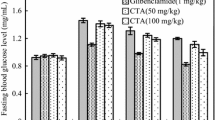Abstract
Hyperglycemia causes increased protein glycation and the formation of early glycation products and advanced glycation end products (AGEs) which are major factors responsible for the complications associated with diabetes. The aim of the present study was to investigate the antioxidant as well as antiglycative potential of ethyl acetate fraction of guava leaves. Oral administration of the extract at different doses showed a significant decrease in blood glucose level. It also showed an improved antioxidant potential as evidenced by decreased lipid peroxidation and a significant increase in the activity of various antioxidant enzymes such as catalase, superoxide dismutase, glutathione peroxidase and glutathione reductase. Glycated hemoglobin as well as fructosamine which are indicators of glycation was also reduced significantly in treated groups when compared to diabetic control. In vitro studies also support the antioxidant as well as antiglycative potential of guava leaves.



Similar content being viewed by others
Abbreviations
- AGEs:
-
advanced glycation endproducts
- CAT:
-
catalase
- DPPH:
-
1, 1-diphenyl-2- picryl hydrazyl
- GPX:
-
glutathione peroxidase
- GRd:
-
glutathione reductase
- PGEt:
-
ethyl acetate fraction of Psidium guajava
- RAGE:
-
receptor for advanced glycation end products
- SOD:
-
superoxide dismutase
- STZ:
-
streptozotocin
- TBARS:
-
thiobarbituric acid reactive substances
References
Aronson D (2008) Hypergycemia and the pathobiology of diabetic complications. Adv Cardiol 45:1–16
Son SM, Whalin MK, Harrison DG, Taylor WR, Griendling KK (2004) Oxidative stress and diabetic vascular complications. Curr Diab Rep 4: 247–252
Garg MC, Ojha S, Bansal DD (1996) Antioxidant status of streptozotocin—diabetic rats. Indian J Exp Biol 34:264-266
Wautier JL, Wautier MP, Schmidt A (1994) Advanced glycation end products (AGEs) on the surface of diabetic red cells bind to the vessel wall via a specific receptor inducing oxidant stress in the vasculature: A link between surface—associated AGEs and diabetic complications. Proc Natl Acad Sci 91:7742–7746
Bolton WK, Cattran DC, Williams ME (2004) Randomized trial of an inhibitor of formation of advanced glycation endproducts in diabetic nephropathy. Am J Nephrol 24:32–40
Arima H, Danno G (2002) Isolation of antimicrobial compounds from guava (Psidium guajava L.) and their structural elucidation. Biosci Biotechnol Biochem 66:1727–1730
Tona L, Kambu K, Ngimbi N, Cimanga K, Vlietinck AJ (1998) Antiamoebic and phytochemical screening of some Congolese medicinal plants. J Ethnopharmacol 61:57–65
Lozoya X, Reyes-Morales H, Chavez-Soto M, Martinez-Garcia M del C, Soto-Gonzalez Y, Doubova SV (2002) Intestinal anti-spasmodic effect of a phytodrug of Psidium guajava folia in the treatment of acute diarrheic disease. J Ethnopharmacol 83:19–24
Ojewole JA (2005) Hypoglycemic and hypotensive effects of Psidium guajava Linn. (Myrtaceae) leaf aqueous extract. Meth Find Exp Clin Pharmacol 27:689–695
Rajbir K, Tarunpreet ST, Bikram S, Saroj A (2009) Inhibition of lipid peroxidation by extracts/subfractions of chickrassy (Chukrasia tabularis A. Juss.). Naturwissenschaften 96:129–133
Yokozawa T, Chen CP, Dong E, Tanaka T, Nonaka GI, Nishioka I (1998) Study on the inhibitory effect of tannins and flavonoids against DPPH radical. Biochem Pharmacol 56:213–222
Suzuki R, Okada Y, Okuyama T (2003) Two flavone C-glycosides from the style of Zea mays with glycation inhibitory activity. J Nat Prod 66:564–565
Ohkawa H, Ohishi N, Yagi K (1979) Assay for lipid peroxides in animal tissues by thiobarbituric acid reaction. Anal Biochem 95:351–358
Kakkar P, Das B, Viswanathan PN (1984) A modified spectrophotometric assay of superoxide dismutase. Ind J Biochem Biophys 21:130–132
Maehly AC, Chance B (1954) The assay of catalases and peroxidases. Meth Biochem Anal 1:357–424
Lawrence RA, Burk RF (1976) Glutathione peroxidase activity in selenium-deficient rat liver. Biochem Biophys Res Commun 471:952–958
David M, Richard JS (1983) Glutathione reductase. In: Bergmeyer HU Jr (ed), Methods Enzym Anal 3:258–265
Szkudelski T (2001) The mechanism of alloxan and streptozotocin action in B cells of the rat pancreas. Physiol Res 50:537–546
Kakkar R, Kalra J, Mantha SV, Prasad K (1995) Lipid peroxidation and activity of antioxidant enzymes in diabetic rats. Mol Cell Biochem 151:113–119
Akhileshwar V, Patel SP, Katyare SS (2007) Diabetic cardiomyopathy and reactive oxygen species (ROS) related parameters in male and female rats: A comparative study. Indian J Clin Biochem 22 :84–90
Shen SC, Cheng FC, Wu NJ (2008) Effect of guava (Psidium guajava Linn.) leaf soluble solids on glucose metabolism in type 2 diabetic rats. Phytother Res 22:1458–1464
Stratton IM, Adler AI, Neil HA, Matthews DR, Manley SE, Cull CA, Hadden D, Turner RC, Holman RR (2000) Association of glycaemia with macrovascular and microvascular complications of type 2 diabetes (UKPDS 35): Prospective observational study. BMJ 321:405–412
Wu JW, Hsieh CL, Wang HY, Chen HY (2009) Inhibitory effects of guava (Psidium guajava L.) leaf extracts and its active compounds on the glycation process of protein. Food Chem 113:78–84
Wu CH, Yen GC (2005) Inhibitory effect of naturally occurring flavanoids on the formation of advanced glycation end products. J Agri Food Chem 53:3167–3173
Ahmed N (2005) Advanced glycation endproducts—role in pathology of diabetic complications. Diabetes Res Clin Pract 67:3–21
Feillet Coudary C, Rock E, Coudary K (1999) Lipid peroxidation and antioxidant status in experimental diabetes. Clin Chim Acta 284:31–34
Jarinyaporn N, Patchareewan P, Veerapol K, Bunkerd K, Kukongviriyapan U (2009) Antihyperglycemic, antioxidant and antiglycation activities of Mulberry leaf extract in streptozotocin-induced chronic diabetic rats. Plant Foods Hum Nutr 64:116–121
Vecera R, Orolin J, Skottova N, Kazdova L, Oliyarnik O, Ulrichova J, Simanek V (2007) The influence of maca (Lepidium meyenii) on antioxidant status, lipid and glucose metabolism in rat. Plant Foods Hum Nutr 62:59–63
Author information
Authors and Affiliations
Corresponding author
Rights and permissions
About this article
Cite this article
Soman, S., Rauf, A.A., Indira, M. et al. Antioxidant and Antiglycative Potential of Ethyl Acetate Fraction of Psidium guajava Leaf Extract in Streptozotocin-Induced Diabetic Rats. Plant Foods Hum Nutr 65, 386–391 (2010). https://doi.org/10.1007/s11130-010-0198-9
Published:
Issue Date:
DOI: https://doi.org/10.1007/s11130-010-0198-9




